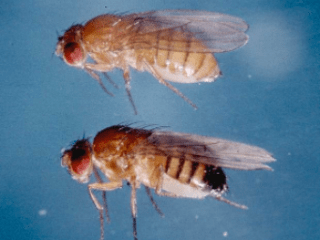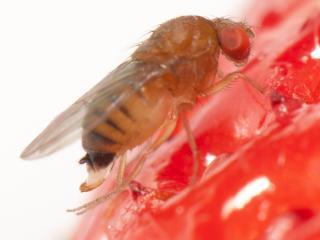
It is not the strongest of the species that survives, or the most intelligent ; it is the one most capable of change
Mots clés: Plasticité phénotypique, Biologie de l'invasion, Température, Drosophila

Phenotypic plasticity and adaptive responses to environmental change
My research work has allowed me to explore different aspects concerning the adaptive responses of organisms to environmental changes, mainly temperature, on the insect model and especially on Drosophila through a comparative approach. I was particularly interested in phenotypic plasticity which can be defined as the ability of a genotype to produce different phenotypes according to environmental conditions. Phenotypic plasticity is a phenomenon that can be generalized to all living organisms and that can be found in all species and for a wide variety of phenotypic traits.
The main questions addressed during my research are :
How to analyze the shapes of non-linear reaction norms? Do these reaction norms present genetic variability? How do these norms evolve between populations and between species? Do these comparisons provide arguments for adaptive phenotypic plasticity?
How will environmental variability (thermal fluctuation) impact the shape of response norms? What about environmental complexity (combination of several factors)?
What is the importance of phenotypic plasticity as a response mechanism to environmental perturbations?
On this issue, I am coordinating the ANR TRAPP project, which started on January 1, 2025 for 4 years and involves two LBBE teams (GEI and ECE), the CASPER unit of Anses in Lyon and the Institut de Génétique Humaine in Montpellier. Agriculture and vector control programs make intensive use of chemical insecticides to control insect pests and disease vectors. They represent a major selection pressure for insect populations.
Transgenerational plasticity (TGP) is a form of non-genetic inheritance in which a change in the phenotype of offspring is triggered by an environmental signal in the parental generation without involving genetic modification. The existence of the TGP process is no longer disputed, but many questions remain, notably concerning the molecular mechanisms of these intergenerational effects and the persistence of TGP over more than two generations. In this project, we propose to use the experimental power offered by Drosophila melanogaster, a model species in physiology, developmental biology and genetics, to explore TGP in response to insecticides. Molecular mechanisms linked to TGP, particularly epigenetics, will be studied. This species can also be considered a sentinel species, representative of insect species exposed to contaminants in most agroecosystems, such as the Drosophila sp. community and the related pest species D. suzukii, but observations can probably be generalized to other arthropods. The study of the transgenerational impacts of insecticides is still little taken into account in insecticide risk assessment.

Drosophila suzukii: a recent biological invasion and a major economic threat
For the past few years, my research activity has focused on a project concerning a very recent biological invasion event involving a fruit crop pest, Drosophila suzukii. At the fundamental level, we were first interested in the ecological factors that explain the invasive success of this species whose biology was poorly known. We showed that French larval parasitoids were unable to control D. suzukii populations because of its very high immune resistance capacity. We also showed that this species has a very wide range of wild host plants present throughout the year and we highlighted an interesting case of self-medication in D. suzukii. Moreover, our results suggest that if D. suzukii does not really have competitors on healthy fruits, it can undergo a strong larval competition with D. melanogaster on rotten fruits on which an oviposition avoidance behavior is observed. Current projects aim to use the recent and spectacular invasion of D. suzukii to better understand the mechanisms of adaptation to a new environment, in particular the role of phenotypic plasticity. Finally, some projects have also been developed to consider new control methods against this formidable crop pest.
Marie Panza's thesis, which I am co-supervising with Laurence Mouton (LBBE) and Vincent Foray (IRBI Tours), focuses on the resistance capacity of the crop pest Drosophila suzukii to a parasitoid recently introduced into France, Leptopilina japonica. To this end, we propose a three-part study: 1) To characterize the variation in resistance to L. japonica between invasive European populations of D. suzukii and look for potential trade-offs with fitness-related traits. 2) Test the influence of environment and microbiota on D. suzukii resistance to L. japonica. This part will focus on the effect of the nutrient environment and the heritable bacterium Wolbachia. 3) Identify the proximal factors underlying variation in resistance to L. japonica. This analysis will investigate the molecular mechanisms underlying intra-specific variation in D. suzukii, but also inter-specific variation between D. suzukii and another Drosophila species, D. melanogaster. From a fundamental point of view, this study will contribute to our understanding of the ultimate and proximal factors involved in host-parasitoid resistance variation. From an applied point of view, it will provide valuable results for the development of a biological control program against D. suzukii and the assessment of risks of resistance emergence. This project is being carried out in close collaboration with our colleagues in the Biological Control Research and Development team at ISA Sophia Antipolis.
Physiological basis of insect community responses to climate change
This collaborative project is led by Cameron Ghalambor (Professor) Norwegian University of Science and Technology, Norwayhttps://www.ntnu.edu/employees/cameron.ghalambor
The earth's climate is evolving rapidly, leading to observable changes in the abundance and geographical distribution of insects. These changing climatic conditions could lead to a global decline or, on the contrary, the growth of certain insect species. Insects play an important role in ecosystem functioning, crop pollination and disease transmission, so understanding the causes of these changes is an important issue for biodiversity, agriculture and human health. To date, our understanding of insect physiological responses to climate change is based mainly on thermodynamic and energetic responses to temperature. However, the integration of the combined effects of temperature on water loss and desiccation risk is important to consider. Insects are particularly vulnerable to desiccation due to their small size and limited water storage capacity. They lose water as the temperature rises across the surface of their cuticle and through high respiration rates.Research has shown that the thermal sensitivity of water loss and metabolism varies from species to species, but no study to date has attempted to systematically describe these patterns in insect groups and in climates varying in temperature and precipitation. We propose to fill this gap by investigating the thermal sensitivity of metabolic rate and water loss in insect species from different climates in Europe. We will combine these data with climate projection models to build new models for predicting how species will respond to future conditions.
Responsabilités
- Membre du Conseil Scientifique du CNRS depuis octobre 2023
- Coresponsable du Living Lab Anthares au sein du PEPR SOLU-BIOD depuis 2023
- Membre de la commission interdisciplinaire 50 ‘Gestion de la Recherche’– 2022-2025.
-
Membre de la Commission scientifique Sciences Exactes et Naturelles-4 (SEN-4) et de la Commission scientifique Sustainability du F.R.S.-FNRS depuis 2022.
Publications
Display of 61 to 90 publications on 116 in total
Plasticité phénotypique et réponses adaptatives aux changements environnementaux chez les insectes
Geographic variations of life history traits and potential trade-offs in different populations of the parasitoid Leptopilina heterotoma
The Science of Nature Naturwissenschaften . 99 ( 11 ) : 903-912
Journal article
see the publicationDifferential thermal performance curves in response to different habitats in the parasitoid Venturia canescens
The Science of Nature Naturwissenschaften . 98 ( 8 ) : 683 - 691
Journal article
see the publicationLocal adaptation and evolution of parasitoid interactions in an invasive species, Drosophila subobscura
Evolutionary Ecology Research . 12 : 873-883
Journal article
see the publicationEcology and life history evolution of frugivorous Drosophila parasitoids
Advances in Parasitology : Parasitoids of Drosophila . 70 : 381 p.
Book chapter
see the publicationEcology and Life History Evolution of Frugivorous Drosophila Parasitoids
Advances in Parasitology . 70 : 6-35
Journal article
see the publicationPhenotypic plasticity of abdomen pigmentation in two geographic populations of TexitDrosophila melanogaster: male-female comparison and sexual dimorphism
Genetica . 135(3) : 403-413
Journal article
see the publicationProximate Causes of Rensch’s Rule: Does Sexual Size Dimorphism in Arthropods Result from Sex Differences in Development Time?
The American Naturalist . 169 : 245-257
Journal article
see the publicationSexual size dimorphism in a Drosophila clade the D. obscura group
Zoology . 109 : 318-330
Journal article
see the publicationGene loss and evolutionary rates following whole genome duplication in Teleost fishes
Molecular Biology and Evolution . 23 : 1808-1816
Journal article
see the publicationGene loss and evolutionary rates following whole-genome duplication in teleost fishes
Molecular Biology and Evolution . 23 ( 9 ) : 1808-1816
Journal article
see the publicationIsofemale lines in Drosophila: an empirical approach to quantitative trait analysis in natural populations
Heredity . 94 : 3-12
Journal article
see the publicationComparative analysis of morphological traits among Drosophila melanogaster and D. simulans: genetic variability clines and phenotypic plasticity
Genetica . 120 : 165-179
Journal article
see the publicationSpecific effects-of cycling stressful temperatures upon phenotypic and genetic variability of size traits in Drosophila melanogaster
Evolutionary Ecology Research . 6 : 873-890
Journal article
see the publicationREML estimates of genetic parameters of sexual size dimorphism for wing and thorax length in Drosophila melanogaster
Journal of Genetics . 83 ( 2 ) : 163-170
DOI: 10.1007/BF02729893
Journal article
see the publicationComparative life histories and ecophysiology of Drosophila melanogaster and D. simulans
Genetica . 120 : 151-163
Journal article
see the publicationDrosophila melanogaster Drosophila simulans: so similar yet so different
Genetica . 120 : 5-16
Journal article
see the publicationPhenotypic plasticity of body pigmentation in Drosophila melanogaster: genetic repeatability of quantitative parameters in two successive generations
Heredity . 92 : 499-507
Journal article
see the publicationREML estimates of genetic parameters of sexual dimorphism for wing and thorax length in Drosophila melanogaster
Journal of Genetics . 83 : 163-170
Journal article
see the publicationCold adaptation in geographical populations of Drosophila melanogaster phenotypic plasticity is more important than genetic variability
Functional Ecology . 18 : 700-706
Journal article
see the publicationPhenotypic plasticity of sternopleural bristle number in temperate and tropical populations of Drosophila melanogaster
Genetical Research . 81 : 25-32
Journal article
see the publicationMicrospatial structure of Drosophila melanogaster populations in Brazzaville: evidence of natural selection acting on morphometrical traits
Heredity . 91 : 440-447
Journal article
see the publicationGenetic variability of sexual size dimorphism in a natural population of Drosophila melanogaster: an isofemale-line approach
Journal of Genetics . 82 ( 3 ) : 79-88
DOI: 10.1007/BF02715810
Journal article
see the publicationMorphometrical evolution in a Drosophila clade: the Drosophila obscura group
Journal of Zoological Systematics and Evolutionary Research . 41 : 64-71
Journal article
see the publicationThe fly that came in from the cold: geographic variation of recovery time from low-temperature exposure in Drosophila subobscura
Functional Ecology . 17 : 425-430
Journal article
see the publicationEvolution of reaction norms In Phenotypic plasticity : functional and conceptual approaches
incollection . 4 : 50-63
Journal article
see the publicationVariable modes of inheritance of morphometrical traits in hybrids between Drosophila melanogaster and Drosophila simulans
Proceedings of the Royal Society B: Biological Sciences . 269 : 127-135
Journal article
see the publicationPhenotypic plasticity of body pigmentation in Drosophila: influence of a developmental thermoperiodic regime in two sibling species
Physiological Entomology . 27 : 124-135
Journal article
see the publicationMale sterility thermal threshold in Drosophila: D. simulans appears more cold-adapted than its sibling D. melanogaster
Genetica . 114 : 195-205
Journal article
see the publicationPhenotypic plasticity of adult size and pigmentation in Drosophila : thermosensitive periods during development in two sibling species
Journal of Thermal Biology . 26 : 351-361
Journal article
see the publication